|
|
|
Sort Order |
|
|
|
Items / Page
|
|
|
|
|
|
|
| Srl | Item |
| 1 |
ID:
107473
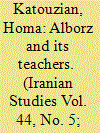

|
|
|
|
|
| Publication |
2011.
|
| Summary/Abstract |
The success story of Alborz High School was due to a number of factors. The legacy of Dr. Jordan and other of its American founders had set unusually high standards of teaching, behavior, discipline and conduct. Dr. Mojathedi managed to maintain those standards through dedication and hard work, even though there was occasional friction between him and students and teachers. Almost all the students, some of them from the upper echelons of society, came from educated and cultured homes, had performed well at their primary schools, were well-motivated, loved their school, ran various cultural programs by themselves, and included notable writers, poets, artist and athletes. Teachers generally maintained discipline, good humor and high standards, and included stars of altogether different varieties such as Zeinolabedin Motamen, Dr. Mahmud Behzad and Mostafa Sarkhosh.
|
|
|
|
|
|
|
|
|
|
|
|
|
|
|
|
| 2 |
ID:
107461
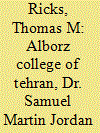

|
|
|
|
|
| Publication |
2011.
|
| Summary/Abstract |
The article addresses the twentieth-century social and cultural history of Alborz College (The American College of Tehran) in terms of its curricula, mission education, the faculty and Dr. Samuel Jordan, founder and president. The courses taught, from the natural sciences and humanities to business and journalism, shaped the lives and aspirations of so many of the graduates for decades. Of great importance were the academic training and personal lives of Dr. Jordan, Mary Park Jordan, and the American faculty, particularly those graduates from Lafayette College (Easton, Pennsylvania) who served as role models of modernity and generous public service that so enriched the lives of their young Iranian charges and won the hearts and minds of the Alborzi graduates.
|
|
|
|
|
|
|
|
|
|
|
|
|
|
|
|
| 3 |
ID:
107471
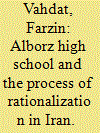

|
|
|
|
|
| Publication |
2011.
|
| Summary/Abstract |
As a leading foundational institution of modernity, Alborz High School under the leadership of Dr. Mohammad Ali Mojtahedi came to embody and promote techno-scientific (or instrumental) rationality that has been the dominant form of rationality in Iran in the twentieth and twenty-first centuries. The essay analyzes this form of rationality and its fostering by Alborz High School during the tenure of Mohammad Ali Mojtahedi. It is argued that while instrumental rationality is necessary for any developing country, it poses fundamental problems for the development of democratic ethos. Alternatively, Jürgen Habermas' notion of "communicative rationality" is proposed and analyzed as a way to complement and democratize Iranian approach toward rationality and modernity
|
|
|
|
|
|
|
|
|
|
|
|
|
|
|
|
| 4 |
ID:
107467
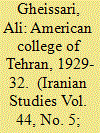

|
|
|
|
|
| Publication |
2011.
|
| Summary/Abstract |
This essay introduces a previously unpublished memorial album of the American College of Tehran compiled by a former student during the early Pahlavi period. The album contains a wide range of contributions by College faculty, associates, occasional visitors as well as fellow students and encompasses material on national history, ethics, sports, military service, mathematics and poetry, as well as numerous pencil drawings and art work. In addition there is a wide range of photographs of the College, its faculty and staff, its diverse student body, classrooms, athletics, special occasions and outdoor activities (a list of the album's contents and samples of contributions and photographs are appended to the essay). As discussed in the essay, and in manifold ways, the documentary evidence illustrates how both physically and cognitively the College provided a necessary space for participation in educational reform during the early decades of the twentieth century. Seen from this perspective, it was part of a wider context of modernization with which a broad range of individuals from different social and community backgrounds and generations identified themselves. On the whole, the album offers valuable glimpses into the social and educational aspects of the early Pahlavi Iran.
|
|
|
|
|
|
|
|
|
|
|
|
|
|
|
|
| 5 |
ID:
107459
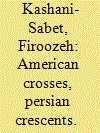

|
|
|
|
|
| Publication |
2011.
|
| Summary/Abstract |
The American public came to know Iran through its missionaries who had lived among the Persians. For their part, Iranians grew familiar with Americans through interactions with these missionary pioneers as well. While American Presbyterians quickly established and expanded their institutional presence in the country, it became abundantly clear to them that Muslim converts to Protestantism remained few and far between. Missionary perceptions of Iranian Muslims, however, left an indelible imprint on American public understanding of Iran and its people. The paper argues that religious ideology frequently colored perceptions and influenced policy-making. Even after more than a hundred years of interaction, cultural representations were refracted through religious difference and similarity. Despite the increasingly secular cultures of Iran and America in the early twentieth century, religion remained a salient ideology for the public in both societies-one that has had a profound impact on the nature of US-Iranian relations. Thus, it is important to analyze the origins and impact of this contact beginning in the nineteenth century.
|
|
|
|
|
|
|
|
|
|
|
|
|
|
|
|
| 6 |
ID:
107469
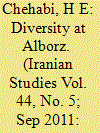

|
|
|
|
|
| Publication |
2011.
|
| Summary/Abstract |
This essay discusses the various dimensions of diversity at Alborz, both when it was run by the American missionaries and when it was under Iranian management. In the first part, the ascriptive traits of human beings are the object of the analysis: gender, race, language, religion and class. In both periods Alborz was characterized by its openness to Iranians of different religious backgrounds, both teachers and students. The second part of the essay discusses the variety of the educational experience enjoyed by students, and concludes that it gradually diminished, as education came increasingly to be defined as instruction and extracurricular activities were reduced after the mid-1960s.
|
|
|
|
|
|
|
|
|
|
|
|
|
|
|
|
| 7 |
ID:
107463


|
|
|
|
|
| Publication |
2011.
|
| Summary/Abstract |
There were many channels of Western impact on nineteenth-century Iran. The military sphere was the first and continued to be of importance throughout the nineteenth and twentieth centuries. Diplomatic interchanges, travelers and new types of economic activity were all influential in opening Iranians to awareness of another world. But perhaps the foremost channel through which the impact of the West was transmitted to Iran was education. Several areas in the educational sphere were important in the influx of Western ideas and ways into nineteenth and early twentieth century Iran. These were: students sent abroad; Western-inspired educational institutions set up by the Iranian government, and later by private individuals; and mission schools. This analysis focuses on the last of these influences and, above all, on the most renowned of the mission schools, Alborz College. In surveying the evidence, one can conclude that mission-provided Western education formed a significant chapter in the early modern period of Iranian history.
|
|
|
|
|
|
|
|
|
|
|
|
|
|
|
|
| 8 |
ID:
107465
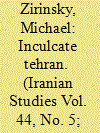

|
|
|
|
|
| Publication |
2011.
|
| Summary/Abstract |
his essay discusses the establishment of Alborz College by American Presbyterian missionaries. Alborz's early years, before its 1940 nationalization by Iran, were shaped by the vision of its first president, Samuel Jordan, a liberal, athletic, pragmatic Christian reformer who led by example, a practitioner of what we now call "social work" and an encourager of female empowerment. Alborz and the Presbyterian mission which gave it birth grew in the context of American social history, including the religious awakening of the early nineteenth century, American doctrines of freedom and universal education, as well as the contradictory impulses of ethnocentricity and ecumenicism. The essay is based on private and governmental archival sources and the experience of the author as a high school student in Tehran.
|
|
|
|
|
|
|
|
|
|
|
|
|
|
|
|
| 9 |
ID:
107475
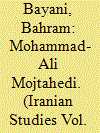

|
|
|
|
|
| Publication |
2011.
|
| Summary/Abstract |
Mohammad Ali Mojtahedi occupies a prominent place in the development of modern education in Iran. Yet, though not a politician, his influence exceeded far beyond education into the social and political life of contemporary Iran. Deeply convinced of the central role of education in development, his career made important contributions to changes in the landscape of modern education in Iran at both high school and university levels. Within this context, the paper traces the outlines of Mojtahedi's life and work from his birth in 1908 in the city of Lahijan in the northern province of Gilan, up to his death in 1997 in southern France. The paper's most seminal contribution covers the events of the period between the summer of 1964, when Mojtahedi was director of Tehran Polytechnic, and his dismissal in February 1967 by the shah as the head of Aryamehr (now Sharif) University which were closely related to the unsuccessful attempt on the shah's life in April 1965.
|
|
|
|
|
|
|
|
|
|
|
|
|
|
|
|
| 10 |
ID:
107477


|
|
|
|
|
| Publication |
2011.
|
| Summary/Abstract |
The paper presents an account of the founding of the Arya-Mehr (now Sharif) University of Technology, and the role that Dr. Mohammad Ali Mojtahedi had in its creation in 1965. The paper describes the landscape of science and technology in Iran in 1965, the year in which Shah Mohammad Reza Pahlavi appointed Mojtahedi to establish this university. It describes the various challenges that Mojtahedi faced in establishing the university, such as avoiding crippling government regulations and bureaucracy, hiring qualified faculty, attracting top students, developing an appropriate milieu for the cultivation of scientific and technological culture and, most importantly, setting the course for the university to become not only Iran's leading institution, but also one of world's credible institutions in science and engineering. The paper also discusses Mojtahedi's unique approach to these challenges, and how, despite his best intentions, he created the animosity and intrigues that resulted in his ousting in 1967. The university did in fact become Iran's leading institution in sciences and engineering, a position which it holds even today.
|
|
|
|
|
|
|
|
|
|
|
|
|
|
|
|
|
|
|
|
|